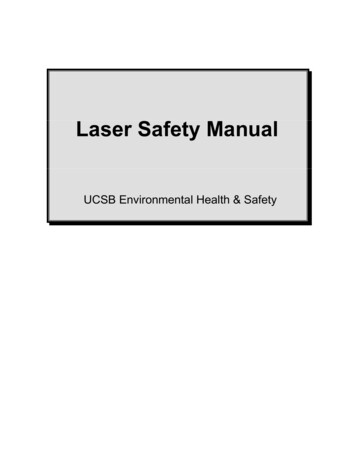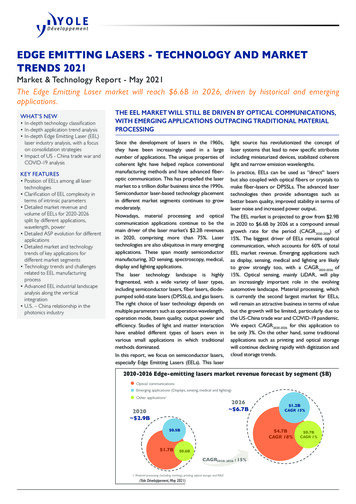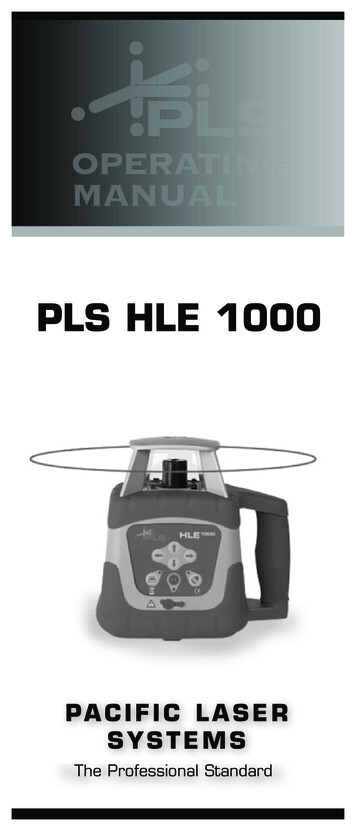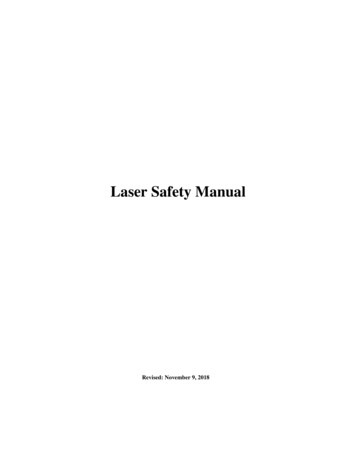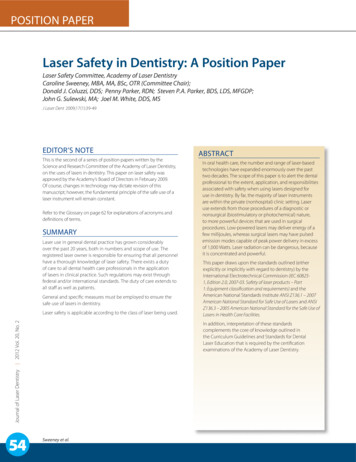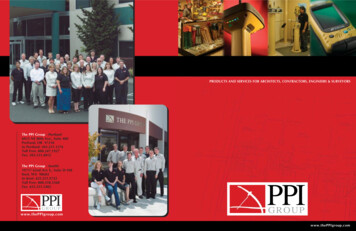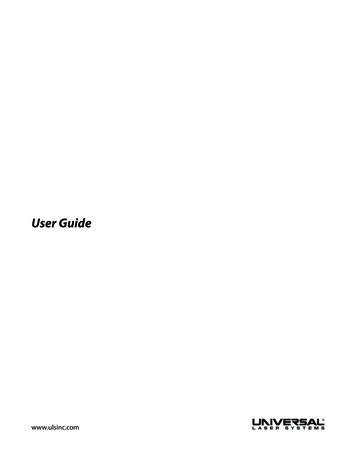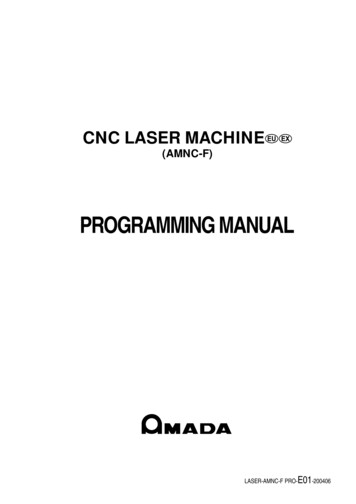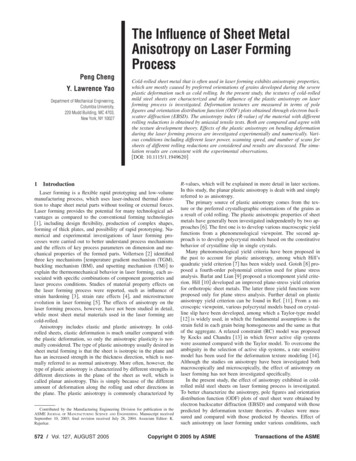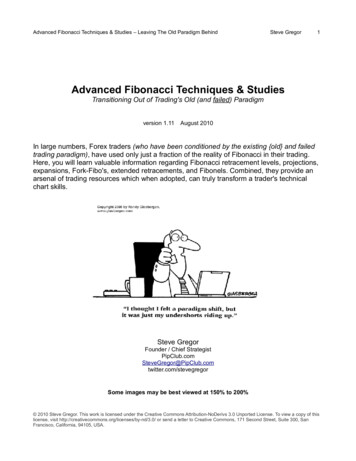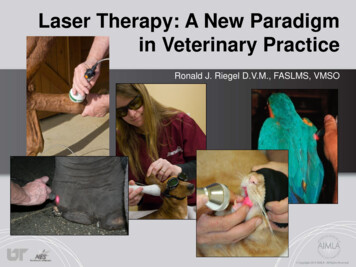
Transcription
Laser Therapy: A New Paradigmin Veterinary PracticeRonald J. Riegel D.V.M., FASLMS, VMSO
“Thank you”The American Institute of MedicalLaser ApplicationsAIMLAwww.aimla.orgEmail: aimladvm@aol.com
Resource informationLaser Therapy inVeterinary Medicine:PhotobiomodulationRonald J. Riegel, DVMJohn C. Godbold, Jr., DVMJohn Wiley & Sons Inc.Publication: Late2016/Early 201743 Chapters37 Contributing earch.gov.Atlas of Class IVLaser TherapySmall AnimalJohn C. Godbold, Jr. DVMCD ROM Edition
Syllabus:8:00 – 9:00Fundamental informationScience, laser-tissue interaction, research evidence9:30 – 10:30 Clinical ApplicationsApplication techniques, common and uncommonapplications.10:45 – 11:45 Interactive session on treatment of specific disordersand anatomical areas.
New technologyRegenerative medicineLaserTherapyStem CellTherapy(Photobiomodulation)Platelet tionedSerumPhysicalRehabilitation
What does laser therapyactually accomplish?1. Relieves pain2. Modulation of the inflammatory response3. Increases microcirculationTherefore an acceleration of the healing process
Scientific Evidenced Based MedicineNumber of Research Papers by Year600500400Low Level Laser Therapy: 4,463articles (increase of 300 in 6months time!)Cold Laser Therapy: 4,540articles300200LLLT: 4,127 articles10002000 2001 2002 2003 2004 2005 2006 2007 2008 2009 2010 2011 2012 2013 2014 2015Photobiomodulation: 186 articleswww.pubmed.comSince Jan. 1st 2016 till 4/10/16: 86 papers on photobiomodulationResearch evidence and clinical evidence is:Evidence Based Healthcare
Part One: FundamentalInformation
Current nomenclatureLow Level Laser Therapy Cold Laser Laser Therapy LightTherapy High Intensity Laser Therapy. LED Therapy LLLT LEDT HILT PhotobiomodulationPhotobioregeneration“The application of electromagnetic radiation within the red andStem cells and PRPinfrared spectrum over injuries and lesions to stimulate healingand pain relief within those tissues”
Laser classificationLasers are classified by potential danger to theeyeClass 1SafeClass 1MSafe provided optical instrumentsare not used****Optical instruments - binoculars, telescopes, microscopes,magnifying glasses (but not prescription glasses)
Class 2These are visible lasers. This class is safefor accidental viewing under alloperating conditions. However, it maynot be safe for a person whodeliberately stares into the laser beamfor longer than 0.25 s, by overcomingtheir natural aversion response to thevery bright light.Class 2MHazardous (even for accidentalviewing) when viewed with the aidof optical instruments
Class 3(1 mw – 500 mw)Laser pointerClass 3R(1 - 5mW)Radiation in this class is consideredlow risk, but potentially hazardousOSHA requires all Class 3 andClass 4 therapeutic lasers usersto wear protective eyewearClass 3B(5 - 500mW)Radiation in this class is verylikely to be dangerous
Class 4(500 mW )Surgical(CO2 and diode)Therapeutic lasersRadiation in this class is hazardous, and viewing ofthe diffuse reflection may be dangerous.Protective eyewear required
PenetrationHow deep does a therapeutic dosepenetrate?
Radiative Transfer Equation--fully describes the energy flowof light in tissue𝟏𝟏 𝒂𝒂𝝓𝝓 𝒓𝒓, 𝒕𝒕(1) 𝒒𝒒𝒒𝒒(𝒓𝒓, 𝒕𝒕) 𝜿𝜿 𝒓𝒓 𝝓𝝓 𝒓𝒓, 𝒕𝒕 𝝁𝝁𝒂𝒂𝝓𝝓 𝒓𝒓, 𝒕𝒕 𝒄𝒄 𝑾𝑾𝑾𝑾𝑾𝑾𝑾𝑾𝑾𝑾:𝝓𝝓 – The Photon Density, is given by:.𝝓𝝓 𝒓𝒓, 𝒕𝒕 𝑺𝑺𝒏𝒏 𝟏𝟏𝝋𝝋 𝒓𝒓, 𝒔𝒔 , 𝒕𝒕 𝒔𝒔′𝜿𝜿 – The Diffusion Coefficient, is given by:𝜿𝜿 𝟏𝟏𝝁𝝁 𝝁𝝁𝒔𝒔′𝟑𝟑 𝒂𝒂(1) Diffusion Approximation to the RTE: μs μa and tissue thickness λ
Light doesn’t suddenly stop“penetrating tissue”
Penetration parametersPOWERCORRECT DOSAGEGIVEN THEAPPROPRIATENUMBER OF TIMESUSING THE PROPERTECHNIQUEWAVELENGTHCONSISTENTCLINICALRESULTS
WAVELENGTH Penetration depth. Absorption. The most important factorPOWER The number of photons atthat depth to saturate thetissues.DOSAGE Joules/cm2. Appropriate number oftreatments . Proper application technique.
Wavelength For effective penetration, the wavelength needs to avoidscattering, surface absorption and absorption by aninWaterAbsorption Coefficient(per centimeter) This is calledthe lobin100CO2 Surgical length (Microns)1020
540nm630nm
475nm 530nm 650nmBlue GreenRed700nm – 1 mm10,600nmInfraredSurgical CO2Depth of penetration is determined by the length of the wavelength
PowerBoth at 980nm wavelength5 Watts10 WattsPower determines the number of photons at that depth.
5 Watt1 WattWavelength 980nm10 Watt
EmissionContinuous wave (CW)FrequencySuper pulsingModulated continuous waveThe terms pulsing and frequency are usedinterchangeably to describe the same concept.TimeFrequency is expressed in Hertz(Hz)The number of cycles per secondthat a waveform repeats5 cycles per second 5Hz
Pulsing/frequencyPulsing mode “X” HzLaser is emitting only 50% of the time.Where is the scientific evidence thatspecific cells respond to a blinking light?
Average power outputAVERAGEPOWEROUTPUTLaser emitting at 10W 10 Joules/sec. 600 Joules/minAVERAGEPOWEROUTPUTLaser emitting at 10W:50%Duty cycle 5 Joules/sec. 300 Joules/min.
SuperPulsed LaserPower (W)161412AVERAGEPOWEROUTPUT1086420050100150200Time (nanoseconds) Average Power Output: 70mWEnergy delivered per minute: 4.2JLaser Classification:1 to 3BOnly feasible for the treatment of small areasPeak (instant power): 25WClaims of deeper penetration and only way toaccomplish analgesia.Garden hose analogy is erroneous:you can’t pressurize photonic energy!
Comparison of time to deliver3,000 JoulesTreatment Area: 300 cm2Dosage:10 J/cm2Total energy delivered: 3,000 J5mW laser10,000 minutes166.7 hours500mW laser100 minutes1 hour 40 minutes3W laser16.7 minutes10W laser5 minutesContinuous wave emission
Laser emitting at 10W:50% Duty cycle:5 Joules/sec. 300 Joules/min.Therapy time 10 minutesLaser emitting at 25W in a super pulsed mode:4.2 Joules/minuteTherapy time 714.28 minutesTherapy time 11.9 hours
Laser/Tissue Interaction
Laser/tissue interactionPhotothermallong pulses, biological effect due to heating hair removal, surgical lasersPhotomechanical (Photoacoustic)short pulsed (q-switched) lasers cause ablation tattoo removal, photorefractive keratectomyPhotobiochemicallaser causes biochemical change or response pain reduction, photodynamic therapy (PDT)
Cellular attraction to infraredlightFibroblasts 3T3 cell cultures800 – 900 nm 47%immediately migratedGuenter Albrecht-Buehler, Ph.D.Fellow, European Academy of Sciences, BrusselsFellow, Institute for Advanced Studies, BerlinRobert Laughlin Rea Professor Emeritus of Cell BiologyNorthwestern University Medical School, Chicago
Mechanism of action at thecellular levelChromophoresare components of various cells and sub-cellularorganelles which absorb light.MitochondriaCell membrane
Photonic energy stimulates the photoreceptor on themitochondria to decrease the reaction time for cytochrome cto become cytochrome c oxidase. This facilitates increasein the cellular respiration rate.Mrowiec, J., et al. 1997NOATPROS
Physiological effectsPhotobiomodulation initiates a biochemical cascade ofevents that results in:1. A reduction in pain2. A reduction in inflammation3. An increase in microcirculationTherefore there is an acceleration in tissuerepair and wound healing
Establishment of an Effective PhotobiomodulationTreatment Protocol in an Animal Model of PersistentNeuropathic PainKetz, A. et al (2015). American Society of Lasers in Medicine and Surgery.The sciatic nerve, sural, common peroneal and tibial nerves were cut.60 rats divided into a sham surgery group and a PBM surgery group.After just two treatments the PBM group began recovery.At day 26, this group reached baseline levels of sensitivity tomechanical stimulus.Phototbiomodulation of the dorsal rootganglion for the treatment of low back pain: Apilot studyHolanda, V.M. et al (2016). Lasers Surg Med.Three groups: lidocaine injection, radiofrequency, or laser therapyLaser irradiation caused an immediate decrease in low back painsimilar to pain reduction cause by lidocaine injection
Mechanism of Action:Analgesia IncreasednitricoxideproductionUozumi et al, August 2010 Farvier et al 2014Increase in beta endorphinsCidral-Filho et al. 2014Decreased bradykinin levelsChow, R.T. and Barnsley, L. 2005Ion channel normalizationRosenbaum, T,PhD, Simon, S, PhD, Islas, L, PhD 2007Stabilizes the action potentialRochkind S, et al. 2000.Increase serotonin Magalhaes,releaseM. et al. 2015Increased release of acetylcholineNicolau, R.A., Martinez, M.S., Rigau, J. and Tomás, J. 2004; Rochkind, S. & Shainberg, A. 2013Blocked depolarizationof C-fiber afferent nervesOhno T. 1997. Tsuchiya K et al. 1993. Wakabayashi, H., et al. 1993
Biochemical/Physiological Cascade ofEvents Resulting in AnalgesiaIncrease in BetaEndorphinsStabilizeActionPotentialSerotonin ReleaseIncreased Nitric OxideProductionANALGESIADecreased Bradykinin LevelsIncreasedAcetylcholineIon ChannelNormalizationBlocked Depolarization of C-Fiber Afferent Nerves
Integration into PainManagement ProtocolsAcute lApproachChronic pain: OA.Post surgical:Routine andorthopedic.LaserTherapyPain free,fast recoveryGood NursingCare andPost y“Divinum est opussedare dolorem”Divine is the work to subdue pain--Hippocrates
Common Pain ManagementApplications in PracticeAcute Pain Management1. Post surgery2. Dental procedures3. Burns4. Otitis5. Urinary disorders6. Gastrointestinal disordersChronic Pain Management1. Osteoarthritis2. Geriatrics3. Dermatologic disorders4. Respiratory disorderse.g. Feline asthma
Clinical Case: Post-op Pain 9 mo. old female spayed ChihuahuaAvascular necrosis - femoral head andneck excisionSx June 4, 2012CRI morphine, ketamine,medetomadine, IA bupivicainePost-op laser therapyCRI morphine, ketamine,medetomadine, IA bupivicainePost-op laser therapy
Post FHO Sx laser therapy protocol Incision: 2 Joules/cm2 Periarticular muscles:Day 1 and 2: 8 Joules/cm2 Periarticular muscles, backand thigh: 6 Joules/cm2 onday 3 then alternate days
Dosage: 2-4 J/cm2
BurnFoot pad meetsstove topDosage:1 – 2 J/cm2
OtitisDosages:Pinna and external structures:2 – 4 J/cm2Ear canal:6 – 8 J/cm2
Cervical disc painDosage:8 – 10 J/cm2
Urinary tract painUroliths FUS Interstitial CystitisPyelonephritis Urethral ObstructionDosage: 10 -12 J/cm2Positioning the patient very important
Gastrointestinal painPancreatitis Parvovirus GI Surgery Dosage:10 – 12 J/cm2; lateral recumb. both sidesand ventrally.Increase dosage for larger patients 60 lbs.
Intestinal resection and anastomosis: Stick and Plastic BodyDosage: 2 – 3 J/cm2 during surgery and before closing incision then 1 –2 J/cm2 after closure. Incision (1 – 2 J/cm2) and abdomen (10 – 12J/cm2) for threeconsecutive days.
Chronic pain management Chronic pain serves no purpose.Stimulus may be persistent – OA.Lasts longer that 1 month.Stimulus may be absent.– CNS malfunctioning– Wind up- central neuronalhyperexcitability
Chronic dermatologicconditionChronic otitis:Dosages:Pina:2 – 4 J/cm2Ear canal:10 – 12 J/cm2Frequency:Daily X 3then EOD for two weeksthen maintenance tomaintain.
Stomatitis6 treatments over 2 weeksPicture taken 1 month later
Chronic respiratory painmanagementFeline asthmaPBMT will provide:pain reliefBeforereduction in inflammationimproved quality of lifeDosage: 6 – 8 J/cm2Frequency of therapy: three out offirst four days then three timesper week then once a week tillAftermanaged.Will respond by 6 – 8 treatmentsCase Study Provided By:Hege Thorsen, BVSc, MRCvSTroll Veterinærklinikk ASKleppestø, Askøy Norway
PBMT modulates theinflammatory reactionarthritisInflammation: īnflammȱ; “I ignite, set alight.”The fundamental acute inflammatory reaction toany form of trauma is ubiquitous regardless of theinciting cause; surgical, pathogenic or physicaltrauma.otitis isenteritisbronchitis
A study of the effects of LLLT using red and NIRwavelengths on acute inflammation in the rodentmodel.Raymond J Lanzafame, MD PLLC;Rochester General Hospital, Rochester NYAmerican Society for Laser Medicine and Surgery Proceedings 2014.LLLT significantly reduced acute inflammation.Comparative analysis of two low-level laser doses onthe expression of inflammatory mediators and onneutrophils and macrophages in acute jointinflammation.Santos, S.; Alves, A.;Leal-Junior, E.;Albertini,R; Vieira, R.;Ligeiro,A.; Silva, J.;Carvalho,P.Lasers Med Sci. 2013 Oct; DOI: 10.1007/s10103-013-1467-2Reductions in IL-1β, IL-6 and TNF-α and inhibition ofinflammatory cells.
Biochemical Mechanisms Resultingin a Reduction of InflammationInhibits the synthesis and secretion of inflammatoryprostaglandin yet stimulates prostaglandins that have avasodilatory and anti-inflammatory action.Assis, L, Moretti, A.I.S, Abrahão, T.B., Cury, V., Souza, H.P., Hamblin, M.R., and Parizotto, N.A.Lasers Surg Med. Oct 2012Stabilization of the cellular membraneQuast RB, kortt O, Henkel J, Dondapati SK, Qustenhagen DA, Stech M, Kubrick S.J Biotechnol. 2015 Jun 10;203:45-53.Enhancement of ATP production and synthesisFarivar S, Malekshahabi T, Shiari RBiological effects of low level laser therapy. Lasers Med Sci. 2014 Spring;5(2):58-62.Stimulation of vasodilatationAcceleration of leukocytic activityKelly A. Larkin, MS, CAT(C); Jeffrey S. Martin, PhD; Elizabeth H. Zeanah, MS; Jerry M. True, DC, FIACN; Randy W. Braith,PhD; Paul A. Borsa, PhD, ATC, FACSM. J. Athl. Trainer, 47(2)178-183.2012Reduction in interleukin 1Alves AC, Vieira R, Leal-Junior E, dos Santos S, Ligeiro AP, Albertini R, Junior J, de Carvalho P Effect of low-level laser therapyon the expression of inflammatory mediators and on neutrophils and macrophages in acute joint inflammation. Arthritis ResTher. 2013;15(5):R116
Stimulation of vasodilatationAn increase in: Nitric oxide Serotonin ROSHonmura A, Ishii A, Yanase M, et al. 1993 Mizokami,T., Aoki K., Iwabuchi, S. et al. 1993Houreld, N.N., Sekhejane, P.R. and Abrahamse,H.;Lasers Surg. and Med. 42:494-502, 2010Ten minutes postDose: 8 J/cm22400 JoulesFifty minutesPromedica Sports Medicine, Toledo Ohio 2009Medial head of Triceps Brachi M
Extensor carpiradialis brevistendonTwo minutes prior to therapy at 10 J/cm2
Ten minutes post therapy
Increasedleucocyte activityIL-1 DecreaseVasodilationReactive oxygen speciesproductionMODULATION OF THEINFLAMMATORYREACTION PGI2 SynthesisCell membraneIncreased production of ATPCa ,Enhanced Lymphocyte ResponseNa , K Ion Changes
Pyotraumatic dermatitisThree hours post administration Dry DecreasedinflammationAdministration of 5 J/cm2Emission of 600 JoulesJohn C. Godbold, Jr. DVMStonehaven Park Veterinary Hospital / Laser Surgery CenterJackson, Tennessee
How does photobiomodulationaccelerate the healing process?Twenty-Six DaysDosage: 4 J/cm2Ten PBMT sessions
Laser Therapy Facilitates Superficial Wound Healing inHumans: A Triple-Blind, Sham-Controlled StudyHopkins et alJ Athl Trainer 2013 Triple-blind, sham-controlled in-vivo human studyidentical skin wounds were created in 22 volunteersage 21 /- 1 years Randomly placed in a control, sham laser or laser treatmentgroup 8 J/cm2, 820 nm laser Measured epithelial migration153% greater wound contraction at day 6 in the laser group
Presented at the 2013 ACSM Annual ConferenceJune 1, 2013High Powered Laser Therapy Enhances Muscle HealingMatthew C. Kostek, Diana C. Delgado-Diaz, Bradley Gordon Subjects underwent muscle damage protocol using isokinetic dynamometer48 hours after damage, laser administered to one leg6 hours after laser treatment, muscle biopsies were collectedC2C12 cells were grown in standard culture conditions and received daily lasertreatmentRESULTS: Laser treatment increased markers of muscle repair and enhancedmuscle cell proliferation in culture.CONCLUSIONS: High powered laser treatment is effective in increasingmolecular markers of muscle repair after damage.
Photobiomodulation in promoting wound healing:a review.Kuffler, D.P. 2016. Regen Med. 11(1):107-22.Data suggests multiple wavelengths more efficacious thansingle wavelength. Focuses on studies of biochemicalmechanisms.Redondo, M.S. (2015) Laser Therapy Approach to Wound Healing inDogs. [ONLINE] Available at: roach-to-wound-healing-in-dogs/. [Accessed 10 February2016].Peplow, P.V. et al. (2010) Laser photobiomodulation of wound healing: areview of experimental studies in mouse and rat animal models.Photomed Laser Surg. 28(3):291-325.
Accelerated tissue repairPhotobiomodulation increases the production of ATPThis increases the energy level of the cell to expedite theuptake of nutrients and speed the elimination of waste byproductsKaru T. et al. 2001Increases the rate of cellular mitosis and collagensynthesisWood, et al. Lasers Surg. And Med. 42:559-565, 2010
There is an increase in the leukocytic and macrophageinfiltrationBolton, P., Young, S.R. and Dyson M. 1991Activates fibroblasts and other tissue repair cell typesThese regenerative cells allow tendons, ligaments,bones and muscles to heal at an accelerated rateAlexandratou, E., Yova, D., Handris, P., Kletsas, D. and Loukas, S. 2002Khadra, M., Lyngstadaas, S.P., Haanaes, H.R. and Mustafa, K. 2005Bjordal et al. 2007).
Biochemical/Physiological Cascadeof Events Resulting in AcceleratedTissue HealingIncreased vascularregenerationEarly cellregenerationIncreased leukocyteIncreased macrophageactivityactivityAccelerated TissueRepairIncreased tensilestrengthIncreased fibroblastproliferationEnhanced celldifferentiationReduced Healing Time
Tendon injuryMarch 10th, 8-year-oldWarmblood show jumper waspresented with an acute rightforelimb lameness after acompetition over a poorsurface.
March 10thForty five day recheck
Wound Healing:Thermal InjuryHistory3 year old spayed femaleEnglish SetterDec 7, 2011- family memberspills cup of hot chocolate overher backNo immediate treatment athomePresented Dec 16, 2012 forreluctance to move, foul odorLaurie Dunbar DVM, CCRP
Treatment Plan:Cephalosporin antibioticsMeloxicamT-shirt to be washed and changed dailyPBMTEOD3 treatments only (compliance, results)
24 hours after first lasertreatmentPost 3 PBMT sessionsClient did not return forfollow up treatments
FRACTURESDelayed or Non-unionSlow healingPoor appositionRoutine as part of post surgicalprotocol
Effect of low-level laser therapy on the fracturehealing process.Kazem Shakouri S1, Soleimanpour J, Salekzamani Y, Oskuie MR.Lasers Med Sci. 2010 Jan;25(1):73-7. doi: 10.1007/s10103-009-0670-7Laser enhances callus development in the early stage of thehealing process, therefore, laser therapy may be recommendedas an additional treatment in non-union fractures in humans.Low-level laser therapy enhances the expression ofosteogenic factors during bone repair in ratsTim CR1, Pinto KN, Rossi BR, Fernandes K, Matsumoto MA, Parizotto NA,Rennó AC.Lasers Med Sci. 2014 Jan;29(1):147-56. doi: 10.1007/s10103-013-1302-9Laser therapy improved bone healing by accelerating thedevelopment of newly formed bone and activating the osteogenicfactors on tibial defects.
Photobiomodulation of adelayed union fracturePugTwo-years-oldDue to economicsopted for ext.fixation:Meta SplintKimberly Juhlin, DVMVale Park Animal HospitalValparaiso, Indiana
Four weeks fracture site stillmobileMade a window in the Metasplint and therapy applied atall anglesTwice/week for five weeksDosage: 8 J/cm2
After five weeks:ten therapy sessions.Resulting angiogenesis anda reduction in edemaresulting in a better healingenvironment.
Bob Marley gets hitby a car!Bob Marley is a yellow Labrador thatwas brought in the day after being hitby a car.He suffered some minor road rash butalso suffered degloving injuries to thepads on his feet.Greg Emmert, D.V.M., CCRP
24 Hours
Conclusions: Scientific and clinical evidenced based medicine. Relieves pain. Modulates the inflammatory reaction. Increases circulation Accelerates healing.
Questions?
Basic Application Techniques
Thank youEmail: aimladvm@aol.comWebsite: www.aimla.orgPhone: 937.642.9813
Low Level Laser Therapy: 4,463 articles (increase of 300 in 6 months time!) Cold Laser Therapy: 4,540 articles. LLLT: 4,127 articles. Photobiomodulation: 186 articles. Research evidence and clinical evidence is: Evidence Based Healthcare. www.pubmed.com. Since Jan.
